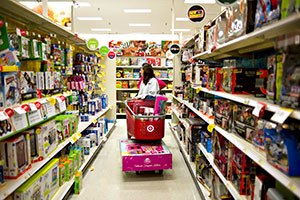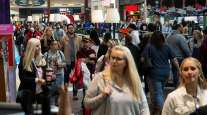Consumer Spending Stalled in April as Americans Saved More

Consumer purchases unexpectedly stalled in April as Americans used income gains to shore up savings, raising the risk the biggest part of the economy may take time to gain momentum after a slow start to the year.
The unchanged reading in purchases followed a 0.5% gain the prior month that was larger than previously estimated, Commerce Department figures showed June 1 in Washington.
The median forecast in a Bloomberg News survey of 79 economists called for a 0.2% rise. Earnings increased 0.4%, more than projected, and the saving rate climbed.
Consumers, who’ve been using the money freed up by low gasoline costs to pay down debt or rebuild their balance sheets, would be more inclined to shop as wages accelerate. Sustained improvement in household spending, which accounts for almost 70% of the economy, is needed to ensure growth rebounds as Federal Reserve officials project.
U.S. consumer spending grew in the 12 months through April at the slowest pace in over five years pic.twitter.com/TFXmjQLC1M
— Matthew B (@boes_) June 1, 2015
“Consumer spending remains a bit restrained,” said Russell Price, a senior economist at Ameriprise Financial Inc. in Detroit and among the top forecasters of spending in the past two years, according to data compiled by Bloomberg. “It suggests a weak start to the quarter and puts growth estimates at risk. I still think things will improve. We’re going to gain some momentum. All the fundamentals are in place for it.”
Projections for spending ranged from no change to a gain of 0.3%, according to economists surveyed by Bloomberg. The previous month’s reading was initially reported as a 0.4% rise. The revised March increase was the biggest since August.
The Bloomberg survey median called for incomes to rise 0.3%. The prior month was unrevised at little changed.
Disposable income, or the money left over after taxes, rose 0.3% after adjusting for inflation. It fell 0.2% in the prior month.
Wages and salaries climbed 0.2%. The saving rate increased to 5.6% from 5.2%.
The report also showed that adjusting consumer spending for inflation, which generates the figures used to calculate gross domestic product, purchases were also little changed in April after a 0.4% increase in March that was the biggest in four months. Spending’s stop-and-go nature helps explain why the growth has slowed.
The economy shrank at a 0.7% annualized rate in the first quarter, revised from a previously reported 0.2% gain, Commerce Department data showed Friday. Household purchases climbed 1.8% following a 4.4% surge in the prior three months that was the fastest since 2006.
While last quarter’s slump reflected bad weather, a wider trade gap caused in part by a strong dollar, and plunging investment in oil exploration related to the drop in fuel prices, economists see many of the restraints dissipating.
Growth may accelerate to a 2.7% pace in the April through June period, with household consumption rising 3.2%, a Bloomberg survey showed in early May. The June 1 data my prompt some economists to reduce their consumer spending forecasts.
The price gauge based on the personal consumption expenditures index was unchanged from the prior month and was up 0.1% from a year earlier. That was the smallest 12-month gain since October 2009.
The core price measure, which excludes food and fuel, rose 0.1% from the prior month and was up 1.2% from April 2014.
Inflation hasn’t been above the Fed’s 2% goal since March 2012.
The strengthening labor market is one reason Americans are likely to keep spending. Payrolls rebounded in April, and the unemployment rate fell to 5.4%, the lowest since May 2008. Weekly applications for jobless benefits are hovering just above a 15-year low reached at the end of April.
Still, wage gains remain paltry. Hourly pay was up 2.2% in April from a year earlier, holding within the narrow range tracked over the past four years.
Consumers are also benefiting from relatively cheap fuel even as gasoline prices have advanced from a six-year low of $2.03 a gallon on Jan. 25. The nationwide average of $2.45 in April was little changed from the March average of $2.43, according to data from AAA, the biggest U.S. motoring group.
Policy makers expect growth to pick up, one reason they’re considering raising the benchmark interest rate that they’ve held near zero since December 2008.
“Households are seeing the benefits of the improving jobs situation,” Fed Chair Janet Yellen said in a May 22 speech in Providence, Rhode Island. If the economy continues to improve as she expects, “it will be appropriate at some point this year” to start raising rates, she said.




